Discovery & general info on the site and its excavation
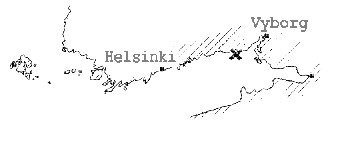 The
Lapuri wreck was discovered by a skin-diver, Manu Törönen, in 1976. It was situated at a depth of 6
m in the straits between Lapuri island and the Siikasaari islet. This locality was a natural
harbour in medieval times according to the dating of underwater pottery-finds. Land upheaval in
this region has been 0.25 m per century. The bottom consists of thin mud, easily movable, on top of
clayey sand layers. Two broad ship planks were partly visible and there was a stone heap at a
distance of 3 m from these. All other remains were covered by sediments. The
Lapuri wreck was discovered by a skin-diver, Manu Törönen, in 1976. It was situated at a depth of 6
m in the straits between Lapuri island and the Siikasaari islet. This locality was a natural
harbour in medieval times according to the dating of underwater pottery-finds. Land upheaval in
this region has been 0.25 m per century. The bottom consists of thin mud, easily movable, on top of
clayey sand layers. Two broad ship planks were partly visible and there was a stone heap at a
distance of 3 m from these. All other remains were covered by sediments.
In 1977 the wreck was partly (about 25%) excavated during a four-day campaign. Only a sample of
the stone heap was lifted for geological analyses. Unfortunately no photos were taken until the
next year, 1978, when a photo-mosaic was made of the re-silted wreck (by Fred Ohert). In 1985 the
site was damaged by an amateur diver, who illegally removed a part of the stone heap. However, the
author in 1989 could easily establish that no real damage had been done to the wreck itself. The
following year the Teredo navalis diving-club (led by Leena Sammalahti) made the first video
recording with relatively poor visibility in the water.
Two excavations have been arranged at the site since then, in the course of 1992 and 1993, led
by Maria Hölttä, under the auspices of the National Maritime Museum of Finland. The stone heap and
the sediment layers were removed from the hull. Visible parts were documented full-scale in situ
on plastic sheets, photographed and videorecorded.
At the end of the 1993 excavations the wreck was covered with a thin cloth and on
top of this an approximately 30 cm sand layer to protect it.
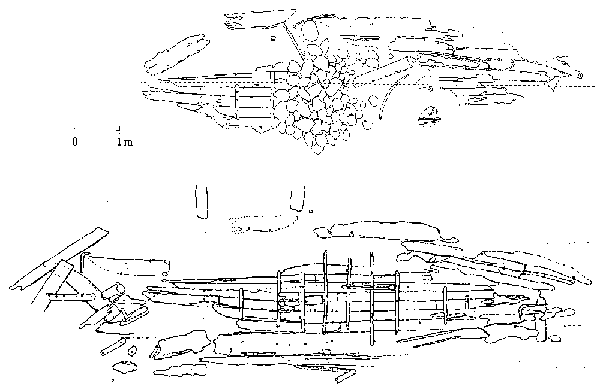
Fig. 1. Sketches of the Lapuri wreck-site 1977 and 1993. Drawing: Harry
Alopaeus.
Dating
The caulking of animal hair was considered to be the most reliable specimen for dating. Its C14
age as of 1977 was 980 +/- 90 years. The first wood sample was unfortunately taken with disregard
to annual rings. This gave a date 200 years too old.
The additional sample in 1993 was taken from a piece of cloth used as caulking in a strake
scarf. The result (Hel-3379) was 570 years BP+/-110 years. There is at present no sufficiently
clear explanation for this huge discrepancy in the datings. Is there any chance of a mix-up of
samples having taken place or pollution by chemical agents? No reservation of this kind could,
however, be directed towards the first two samples.
Geological conditions: currents, sedimentation, erosion
In the Lapuri straits currents change irregularly and very frequently. The wreck had been partly
covered by sediments since 1977. The sediments of the aft part had been eroded during these few
years. In order to estimate the process of sedimentation some samples were taken in the wreck and
outside of it. So far no analysis of these specimens has been undertaken. It was observed, however,
during field research that sand sucked up by the airlift was sometimes transported back by the
current to produce a sand rain, which gave a layer of up to 5 cm on a bad day.
State of the wreck in 1977
The wreck had been flattened out on the sea-floor by the weight of the stones. The port side was
more damaged than the starboard side, since the hull had been tilted to the latter. The stones had
also apparently been rolled over to the starboard side before sinking. Most of the frames had been
broken under the weight of the stones, but their original shape seemed to be possible to
reconstruct.
Short description
The remains are c. 980 cm long and 330 cm broad. It has been surmised that the original height
of the hull must have been at least 80 cm and the height from keel to the top of the stem c. 230 cm
at the maximum.
After sinking, the hull has gradually been flattened out on the floor and was during the
excavations c. 20-25 cm in profile (the stone heap excluded).
Position of the keel and the tilt
The measurements taken indicate that the keel of the wreck in now slightly bent in longitudinal
direction c. 4º. The forward end lies 7º from the horizontal level, while the aft end ends up only
4º from the same level. The difference in angle between the stem and the stern, 3º, shows that the
keel is bent. It is not clear whether the curve is original – which is quite possible judging from
other Viking-Age ships – or if the stone heap bent is secondarily.
The stern points to the north, according to the direction of the plank scarfs. The keel in the
stem is tilted 7º to starboard, while the stern displays 16º. Measurements have been taken from the
flat upper side of the keel.
The keel is in fact quite low (below). It appears therefore that the earlier opinion that an
assumed high keel had been instrumental in the tilt is false.
The stones
The tilt could have been caused by the stones. Inside the hull were 268 stones of different
sizes with a combined weight of 1400-2000 kg. About 70% of them concentrated on the starboard side.
Yet the heap was evenly distributed and shows no sign of a slide. Thus it seems that an
asymmetrically loaded heap of stones has forced the hull to starboard at the moment of sinking.
The mineral content of the stones has been analyzed. They all appear to be granite of local
origin. Before the removal in 1982 each stone was numbered, drawn and weighed individually
underwater. They were placed in the "stone farm" c. 7 m from the port side of the wreck.
Already in 1977 two ends of planks were observed under the stones, but above strake no. 4 on the
stone-heap side. These planks were accordingly thought to be parts of a ceiling, to protect the
frames and the outer planking from the ballast stones. The problem was that we already knew that
the stones were of local origin. It appeared therefore that they could not be ballast.
While dismantling the stones in 1982 it became obvious that there were no ceiling. Only
fragments of two short planks were found under the stones (at frame 4), precisely those which had
been observed in 1977.
Thus the obvious conclusion seems to be that the stones were not intended as ballast but rather
as a heavy load to keep the ship on the sea floor.
Planking
The very thin but broad oaken planks are characteristic. At frame 4 the bottom planks 2-3 are
not eroded, but still only 1.4 cm thick. Most of the preserved planks are of the same thickness or
even thinner.
All of the salvaged and studied planks have been made by splitting a big trunk radially in the
manner so familiar from the Skuldelev ships. The broadest plank
is c. 55 cm wide, but only c. 1.5 cm thick. For the seams there has been used animal-hair caulcing,
in the plank joints (at least two) a tarred woolen cloth.
However, the method of fastening the planks is unusual for this age. The ship is clinker-built
but the strakes are fastened to each other alternately with iron rivets with square or rhombic
roves on the inside and with wooden pegs (treenails) of a diameter of (10-)12 mm. The iron rivets
have square shanks, 5x5 mm and are placed at a distance of 20-23 cm from the intervening treenails.
At places there are irregularities in this pattern. There can, for example, be 2-5 rivets in an
unbroken sequence followed by one treenail.
The fastening of the strakes to the frames is done in the usual way, with wooden pegs with a
diameter of c. (20)-22 mm.
Near the stem one of the hull planks was found on the sea floor (strake no. 3, counting from the
keel). This plank appears to have been bent in the direction of the keel. Accordingly, this shape
gives interesting information about the build-up of the fore part of the ship.
Strake no. 1 in the aft part goes further than the keel. The plank end has eroded to such an
extent that the hood end cannot be discerned. The same observation can be made for plank no. 2 on
the starboard side and the corresponding plank on the port side is missing altogether.
Two broad planks were found under a sediment layer of c. 10-15 cm. Both are important because
they still preserve very clearly the scarf end to the stern.
It is remarkable that the higher placed planks are not eroded and in fact in rather good
condition while the next two lower planks are severely eroded. Together with the actual positioning
of the planks on the sea floor this fact may be taken to indicate human activity at the site fairly
soon after the sinking of the ship. An anchor or something else seems to have crushed the aftmost
part of the ship from starboard to port and to have spread the planks over the sea floor. Whether
by purpose or just accidentally cannot be established. The straits at Lapuri were, as mentioned, a
medieval overnight haven.
Near the aft end was found a thin but broad plank with a somewhat unusually shaped end. It is
cut diagonally instead of straight, which is the normal form in the wreck. No definite conclusion
can be drawn as to its background, whether it is poor craftsmanship or the result of following the
local tradition.
The sample of wool under a plank joint
A sample of the cloth for the caulking was taken under a joint at strake no. 3. The wool in the
cloth has been identified as coming from an eastern race of sheep.
Repair of a strake
Obviously the ship was in fairly bad condition before the sinking. At least one
repair has been found, on the port side, between frames nos 5 and 6. The repair patch has been
fastened to the plank by rivets.
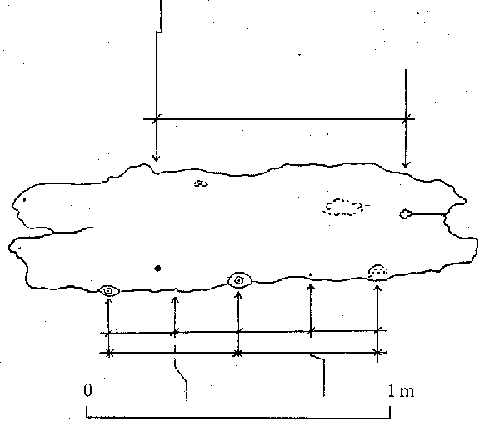
Fig. 2. Piece of a plank with impressions of rivet plates. Drawing: Harry
Alopaeus.
Railing
A wooden lath was found immediately outside of the starboard side, between frames
nos 4 to 6 and alongside the outermost strake. It has been taken to be a section of the port side
rail (gunwale). The lath is approximately square in cross-section and wooden pegs go through it
both horizontally and vertically.
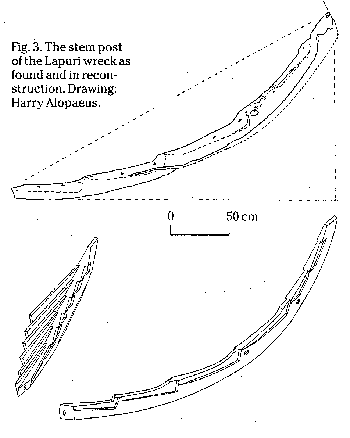
Fig. 3. The stem post of the Lapuri wreck as found and in reconstruction.
Drawing: Harry Alopaeus.
Frames
The distances vary between the frames midships and in the ends of the boat. Starting from the
stem the distance between frames 1-2 is about 110 cm, the next (2-3) c. 80 cm, 80 cm between frames
4-5, 50 cm between 6,7,8; 50 cm between 9-10, 55 cm between 10-11 and 70 cm or more between 11-12.
The frames mostly reach half way up strake no. 4. Only those frames which appear to be of
lighter wood reach higher (even up to strake no. 5), e.g. 6 and 8. There are limber holes in the
frames. Their form is usually oblong. At the seam of strakes 1 and 2 another draining hole has been
observed, like a V turned upside-down.
Stem
About 40 m south of the wreck was found a curved piece of oak wood. It is probably the stem of
the wreck, since it has two holes (for a rope?) in its lower part. No other wreck is known to exist
in the Lapuri straits, so it is reasonable to assume that it belongs to "our" ship. The hood ends
have been fitted to the stem in a very old-fashioned way. Thus, the lapstrake position of the
strakes continues to the very end. But the same kind of "fully clinkered" construction has survived
in Finland (with the Åland islands) and some places in Sweden into the 20th century in
the clinker-built bondeseglare (farmer-sailor).
The keel, size and form
The length of the T-formed keel is 702 cm and the maximum width inside the hull is
22 cm. The height was measured to be 13-14 cm of the lower standing part takes 11 cm. The width of
the underside of this standing part is 8-11 cm. These measurements were taken between frames 3 and
4 in the aft part. In 1977 the end of the keel was measured to be c. 16 cm high, which it is 50 cm
up the ends. This obviously means that it is a little higher in its fore and aft part than
midships.
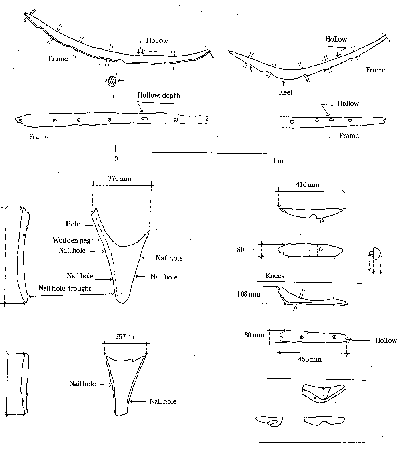
Fig. 6. Details of frames and knees from Lapuri. Drawing: Harry Alopaeus.
Keelson with low arc
Only the aftmost part of the keelson is preserved under the stones. But the forward part must
have been partly visible under the stones, if it had been in position when the ship was sunk. It
appears that there are two alternative explanations: 1) the keelson was broken off and removed
before the loading of the stones. 2) An anchor has, after the sinking, ripped away the forward part
of the keelson.
The preserved part of the keelson covers frames 7 and 8, ending at frame no. 9, where it
ap-pears to have been broken at the possible mast step. The remaining part has been placed c. 2 m
forward from midships. It is fairly severely eroded but it can nevertheless be observed that it was
originally quite light and small. Thus, the mast of the ship cannot have been big or heavy.
A part of the keelson, that between frames 8 and 9, is flat. The wood has
accordingly been in contact with the keel for its full length. Between frames 8 and 7 there is a
low arc (only 1-1.5 cm; from three directions).
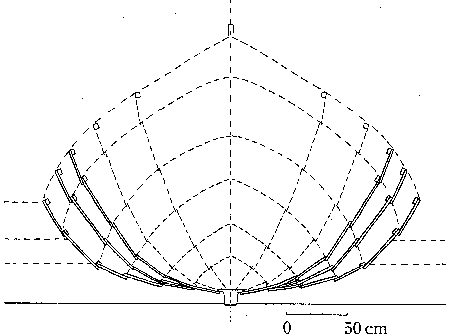
Fig. 7. Preliminary reconstruction drawings of the Lapuri find. Drawing:
Harry Alopaeus.
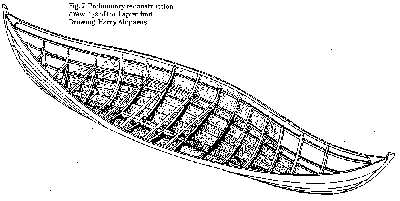
The stringers
Short pieces of stringers were found at two places along the plank seams. Their rabbets have
also been observed on a few frames (e.g. frames 3,4 and 9). Otherwise it seems that stringers are
totally missing (e.g. at frames 5,6,7 and 8). It is possible that repair work prior to the sinking
included the dismantling and renewal of some of the frames. The stringers or rather parts of
stringers may not have been replaced at these frames.
It could also be observed that some of the strakes are paler in colour than other parts of the
ship, even though they ought to be oak. The analyses of the wood have not yet been finished.
A support for the rudder pivot?
A little beyond the aft end of the keel was located a wooden object, 92 cm long, 16.4 cm broad
and 6.4 cm thick. On one side the object had several holes of different sizes. On the other side a
groove ran along almost its full length.
The function of it is unknown. But a reasonable guess would be a support for the rudder. It
would have been placed near the starboard ship's rail to protect it from wear.
Other parts of ship construction
About 12 m to the north of the wreck was found a thin, severely eroded beam. Its present length
is as great as 297 cm, with a breadth of 8.1 cm and thickness of 6.3 cm. In its eroded end it has
wooden pegs, possibly for the fastening of a knee. Of such knees there were found at least four in
or near to the wreck. The cross-section of the beam is triangular in shape. If it served as a bite
(cross-beam or thwart), it could indicate the original width of the hull. However, the totally
eroded opposite end does not give any indication of its nature.
Loose objects
Only very few loose objects have been found: a net sinker, two unidentified wooden objects,
three grinding stones and – from three different places – fragments of a bronze kettle. Probably
these fragments belong to the same pot.
Sinking or accident?
Was the Lapuri ship sunk on purpose or by accident? The archaeological material appears to be
ambiguous. If it was intentionally sunk, how are we to explain the three grinding stones or the
fragments of the bronze kettle? Why were they left behind if the ship was stripped and sunk? Maybe
that question is a little less serious than the next one.
On the other hand, if the ship was sunk in an accident: how do we explain the lack of items in
the hull and the total lack of ceiling, the missing front part of the keelson and the local type of
stones found inside the hull?
No definite answer can thus be given. The only reasonable hypothesis the present
author can offer is that the ship was part of a convoy and that it sprang a leak (and/or lost a
mast with part of its keelson) near the Lapuri strait. Its cargo was taken off and the ship itself
pulled ashore for repair. Perhaps it was not possible to repair it anymore. It was decided to
abandon it. The hull was pushed out into the water, stones from the beach were loaded into it
without protecting the inside of the ship by putting back the ceiling. The ship was towed about 80
m from the shoreline and sunk in the straits at a depth of 8 m. The secondary damage seen in it
must then have been unintentional and inflicted by crews of ships at the night anchorage in the
Lapuri straits.
This text has been overhauled by C Westerdahl, to whom the author offers his
heartfelt thanks. The article has been published in Shipshape, The Viking Ship Museum,
Roskilde 1995.
Published in June 1997 on Nordic Underwater Archaeology by
permission from the author. Protected by international copyright.
Layout by Per Åkesson. Thanks to Divex for
scanning.
Notes
- Andersen 1963.
- Forssell 1983.
- Ibid.
- Vilkuna, Taavitsainen & Forssell 1992.
- Naskali 1979.
Bibliography
Published
Alopaeus, Harry. 1989. Der Schiffsfund von Lapuri. Deutsches Schiffsarchiv 11,
1988, pp. 21-34.
Andersen, Gunlög. 1963. Boatgraves in Finland. Suomen museo LXX, pp. 5-23.
Helsinki.
Ericsson, Christoffer H. 1977. Viking ship remains in Finnish waters. In: Annual
Report. The National Maritime Museum of Finland, pp.4-5. HeIsinki.
Forssell, Henry. 1980. Ett medeltida båtfynd vid Åbo slott. Finskt museum 1980,
pp. 11-21. Vammala.
Forssell, Henry. 1983. Fynd av sydda båtar i Finland. Båtar I. Skärgårdsmuseet,
Pernå. Lovisa.
Naskali, Eero. A boat find in Rääkylä. A preliminary report. In: Annual Report
1979. The National Moseum of Finland, pp. 2-6. Helsinki.
Vilkuna, J., J.P. Taavitsainen, H. Forssell. 1993. Suojoki in Keuruu. An ancient
boat harbour in Central Finland. In: J. Coles, V. Fenwick R G. Hutchinson (eds) : A Spirit of
Enquiry. Essays for Ted Wright, pp. 85-90. Exeter.
Unpublished
Hölttä, Maria. Lapurin kenttätutkimusrapportti 1992 (Field research report
1992). Archives of the National Maritime Museum of Finland, Helsinki.
Hölttä, Maria. Virolahden Lapurin hylyn kenttätutkimusrapportti 1993 (Field
research report on the Lapuri wreck of Virolahti parish). Archives of the National Maritime Museum
of Finland, Helsinki.
Personal communication from Maria Hölttä, student of archaeology at the
University of Helsinki. |

 The
Lapuri wreck was discovered by a skin-diver, Manu Törönen, in 1976. It was situated at a depth of 6
m in the straits between Lapuri island and the Siikasaari islet. This locality was a natural
harbour in medieval times according to the dating of underwater pottery-finds. Land upheaval in
this region has been 0.25 m per century. The bottom consists of thin mud, easily movable, on top of
clayey sand layers. Two broad ship planks were partly visible and there was a stone heap at a
distance of 3 m from these. All other remains were covered by sediments.
The
Lapuri wreck was discovered by a skin-diver, Manu Törönen, in 1976. It was situated at a depth of 6
m in the straits between Lapuri island and the Siikasaari islet. This locality was a natural
harbour in medieval times according to the dating of underwater pottery-finds. Land upheaval in
this region has been 0.25 m per century. The bottom consists of thin mud, easily movable, on top of
clayey sand layers. Two broad ship planks were partly visible and there was a stone heap at a
distance of 3 m from these. All other remains were covered by sediments.




 Back to Nordic Underwater Archaeology
Back to Nordic Underwater Archaeology